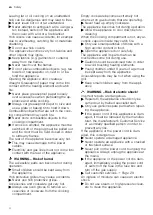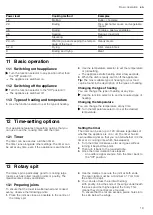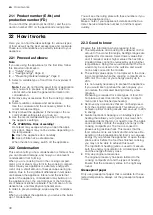
en
Operating the electric hotplate
18
Note:
Information
¡
* If you are using a pan with a lid, turn the flame
down as soon as the food starts to boil.
¡
** Optional. Available for some appliances. Depend-
ing on the appliance type. (For frying on the wok
burner, we recommend that you use a wok.)
10 Operating the electric hotplate
You can find out everything you need to know about
operating your electric hotplate here.
10.1 Before using the electric hotplate
for the first time
WARNING ‒ Risk of harm to health!
When heating up the hotplate for the first time, vapours
are released which may lead to irritation of the mucous
membranes.
▶
The kitchen should therefore be well ventilated.
▶
Stay in the kitchen for a short time.
▶
Keep children, pets and particularly vulnerable
people away from the room.
ATTENTION!
If you operate the electric hotplate without cookware,
this may lead to damage to the electric hotplate.
▶
Except for during initial heating, always operate the
electric hotplate with cookware.
1.
Ventilate the room while the electric hotplate is heat-
ing.
2.
Switch off the electric hotplate after the specified
cooking time.
3.
Wait until the hotplate has cooled down.
10.2 Important information about the
electric hotplate
Follow these instructions when using your electric hot-
plate.
¡
Do not switch on the electric hotplate without pla-
cing cookware on it.
¡
Only use cookware with a dry base. Avoid overflow-
ing liquids and using wet cookware.
¡
Residual heat is present after the electric hotplate is
switched off. Keep children at a safe distance.
¡
Ensure that the selector for the electric hotplate is
switched off in the event of a power failure.
¡
We recommend that, at the beginning of the cook-
ing process, you turn the selector to the highest
level and then select an intermediate position based
on the quantity and consistency of the food.
¡
If the diameter of the cookware base does not cor-
respond to the hotplate or if the cookware base is
uneven, unnecessary energy is consumed. Use
cookware with a thick, flat base, the diameter of
which matches the diameter of the hotplate. Never
use cookware with a smaller base.
¡
The hotplate can be switched off before the end of
the cooking time in order to exploit the thermal iner-
tia. To save energy, you can continue cooking for a
while with the heat that has already been produced.
¡
Overflowing liquid is burnt on and leaves hard-to-re-
move stains. Use cookware with a suitable diameter
in order to prevent an overflow.
¡
Due to the high heat effect, the metallic hotplate ring
may discolour over time. Rectify the discolouration
by cleaning the hotplate ring with the rough side of
a sponge with washing-up liquid or abrasive clean-
ing agents. When cleaning, ensure that the sponge
does not come into contact with the hotplate.
¡
If the surface of the electric hotplate is dirty as a
result of long-term use, clean the surface with a few
drops of oil or standard care products.
10.3 Switching on the electric hotplate
ATTENTION!
If you operate the electric hotplate without cookware,
this may lead to damage to the electric hotplate.
▶
Except for during initial heating, always operate the
electric hotplate with cookware.
1.
Open the top cooker cover.
The top cover must remain open for as long as the
hotplate is in operation.
2.
Place suitable cookware on the electric hotplate.
3.
While taking into consideration the cooking mode
and the quantity of food as well as using the picture
below as an aid, turn the selector anti-clockwise to a
suitable position.
a
The function display lights up.
10.4 Switching off the electric hotplate
Residual heat is present after the electric hotplate is
switched off.
▶
Turn the selector to the 0 position.
a
The function display goes out.
10.5 Recommended cooking settings
You can find an overview of different foods with appro-
priate heat settings here.
The cooking time will vary depending on the type,
weight, thickness and quality of the food. Select the
right cookware size for each hotplate. The diameter of
the cookware base should be the same size as the hot-
plate.
Note:
In these cases, increase the output:
¡
When cooking with larger quantities of liquid,
¡
When preparing larger quantities,
¡
When using cookware without a lid.
















































